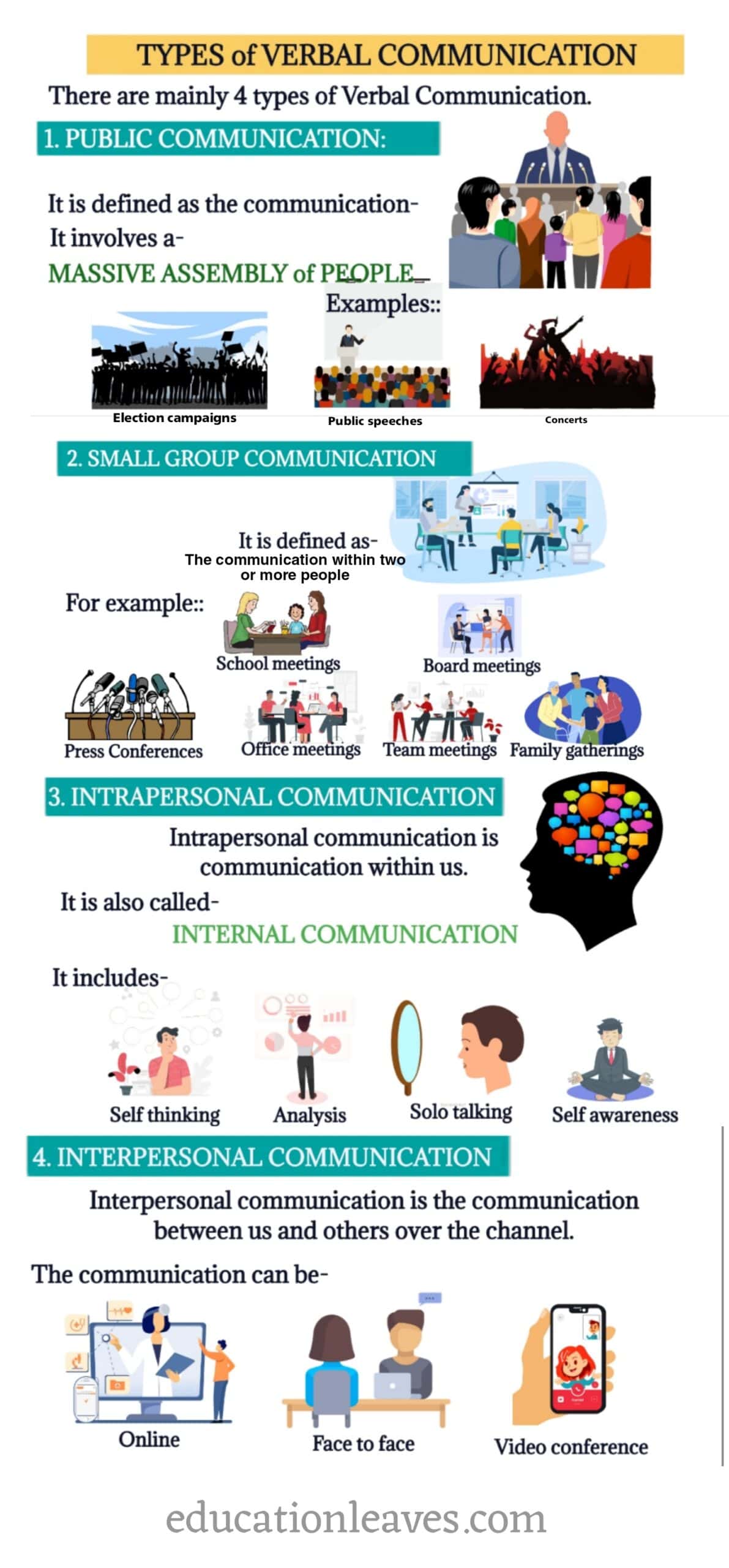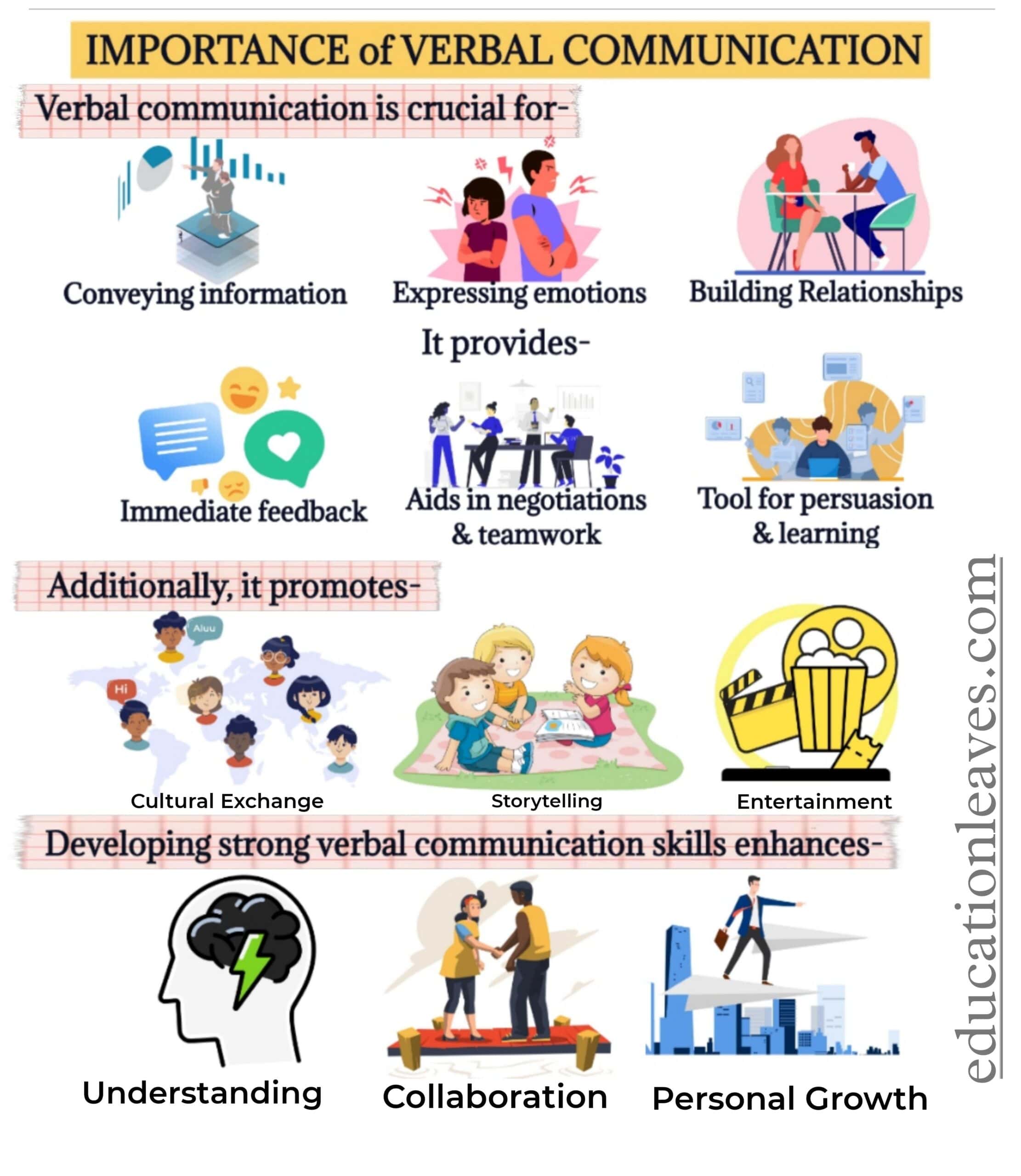Before we know about Verbal communication, we should know what communication is.
We can describe communication as exchanging information, ideas, thoughts, feelings, or messages between individuals or groups. It’s a primary aspect of human interaction that allows us to convey and receive information, share our thoughts and emotions, and build connections.
There are many types of communication, and verbal communication is one of them. In this article, we’ll delve into the art of effective verbal communication, exploring techniques and strategies to help you become a more confident and impactful speaker.
Verbal communication is a way of sharing information, thoughts, ideas, and feelings using spoken words. It’s one of the most common forms of communication among humans. When we talk to someone, whether in person, over the phone, or through a video call, we are engaging in verbal communication.
What you are going to learn?
Understanding Verbal Communication
Verbal communication is the process of sharing information, emotions, and ideas through spoken words. It is the most common form of human interaction, surrounding conversations, speeches, and dialogues.
Verbal communication not only relies on the choice of words but also on elements like tone, pitch, and intonation, which can convey emotions and nuances. Clear pronunciation and expression are essential for effective verbal communication, as they ensure that messages are understood correctly. Whether in informal conversations with friends or formal presentations to an audience, verbal communication plays a crucial role in connecting people, sharing knowledge, and conveying thoughts and feelings.
Key Elements of Verbal Communication
The key elements of verbal communication contain various aspects that contribute to effective verbal interactions. These elements include:
- Words and Vocabulary: The choice of words is essential to conveying messages correctly. Using relevant and clear language confirms that the intended meaning is understood.
- The tone of Voice: The tone, or how the words are spoken, can express emotions, attitudes, and intentions. It includes elements like pitch (high or low), volume (loud or soft), and rhythm (fast or slow).
- Pitch and Intonation: Pitch is considered as the highness or lowness of one’s voice, while intonation involves variations in pitch during speech. These elements can add priority, express excitement, or indicate questions.
- Clarity and Pronunciation: Clear and accurate pronunciation of words is crucial for understanding. Correct pronunciation helps prevent misunderstandings.
- Pauses and Silences: Pauses and silences in speech are necessary for understanding. They give listeners time to process information and can highlight critical points.
- Speed and Pacing: The speed at which one speaks can affect understanding. Appropriate pacing allows listeners to follow the conversation with ease.
- Volume: Adjusting the volume of one’s voice to fit the context is important. Speaking loudly in a noisy environment and softly in a quiet setting helps assure the message is heard.
- Language Register: Adapting language to the audience and context is necessary. Different situations need different levels of formality, and using proper language registers is crucial for effective communication.
- Listening Skills: Effective verbal communication involves active listening. Being attentive, asking clarifying questions, and providing feedback when required demonstrate active listening skills.
- Non-Verbal Cues: Non-verbal elements such as facial expressions, gestures, and body language often complete spoken words, adding depth to the communication.
- Context: The context in which communication happens, including the setting, cultural norms, and the relationship between the communicators, can significantly influence how messages are received.
- Feedback: Providing feedback during a conversation helps ensure that both the speaker and listener are on the same page and that the message is comprehended as intended.
- Empathy: Understanding and considering the emotions and perspectives of others is crucial for effective communication, especially in sensitive or emotional conversations.
These components work together to facilitate clear, meaningful, and impactful verbal communication. Mastering them can improve one’s ability to convey ideas, build relationships, and engage effectively in conversations and presentations.
Types of Verbal Communication
There are mainly 4 types of verbal communication:
- Public Communication:
- It is defined as the communication of a person with the public. It involves a massive assembly of people. Examples of public communication include- Election campaigns, public speeches, any type of concert, and so on.
- Small Group Communication:
- Small group communication is defined as communication between two or more people. The number of people participating in such communication is enough to have a good interaction with each other; For example, school meetings, board meetings, press conferences, office meetings, team meetings, family gatherings, etc.
- Intrapersonal Communication:
- Intrapersonal communication is communication within us. It is also called internal communication which is associated with the inner state of mind. It includes self-thinking, analysis, solo talking, self-awareness, etc.
- Interpersonal Communication:
- Interpersonal communication is the communication between us and others over the channel. The communication can be online, face-to-face, video conference on mobile, etc.
- Interpersonal skills are essential, whether we are a manager, employees, or looking for work. Such skills are also known as soft skills that determine how well a person can communicate, behave, and relate to others.
If we categorize verbal communication based on the purpose and nature of the communication, then there are 4 more types of verbal communication that exist:
- Informative Communication:
- This type of verbal communication is concentrated on conveying facts, data, or information. It aims to educate or inform the listener. Examples include lectures, presentations, news reports, and educational conferences. In informative communication, the goal is to provide factual and valuable information to the audience.
- Expressive Communication:
- Expressive communication is all about sharing emotions, feelings, and personal thoughts. It’s used to express joy, sorrow, anger, love, or any other emotion. Expressive communication can be done through conversations, poetry, storytelling, and even art forms like music and dance. It allows individuals to convey their inner thoughts and connect with others on an emotional level.
- Persuasive Communication:
- This type of communication is created to influence or persuade the audience to adopt a distinct viewpoint, take action, or make a decision. Persuasive communication is commonly used in advertisement, marketing, sales, political speeches, and debates. It uses persuasive techniques, such as compelling arguments and emotional appeals, to convince others.
- Directive Communication:
- Directive communication involves giving instructions, orders, or advice to achieve a specific outcome. It is prevalent in educational fields (teachers instructing students), workplaces (managers assigning tasks to employees), and everyday life (giving tips or following recipes). Directive communication aims to provide clear and actionable guidance to assure that tasks are carried out effectively.

Importance of Verbal Communication
Verbal communication has several key roles and benefits:
- Expressing Thoughts and Ideas:
- Verbal communication allows individuals to convey their thoughts, ideas, and opinions to others. It’s the primary means through which we can share information and knowledge with others.
- Effective Information Sharing:
- Verbal communication is often the most effective way to convey complex or detailed information. In professional settings, clear verbal communication is important for relaying instructions, sharing data, and discussing strategies.
- Building Relationships:
- Engaging in conversations fosters relationships and connections. Whether in personal or professional contexts, the ability to communicate verbally helps people to build trust, empathy, and connections with others.
- Conflict Resolution:
- Verbal communication plays an important role in resolving conflicts and misunderstandings. It allows individuals to discuss their differences, find common ground, and negotiate solutions.
- Decision-Making:
- Group discussions and meetings depend heavily on verbal communication to facilitate decision-making processes. Participants share their viewpoints and ideas, leading to informed choices.
- Teaching and Learning:
- Verbal communication is a primary tool in education. Teachers use it to guide students, explain concepts, and simplify learning. Students, in turn, use verbal communication to ask questions and seek clarification.
- Social and Cultural Bonding:
- Conversations and storytelling through verbal communication are central to cultural identity and heritage. They help maintain traditions, customs, and history within societies.
- Emotional Expression:
- Verbal communication allows individuals to express their emotions and feelings, whether it’s sharing joy, sorrow, anger, or love. This emotional expression is crucial for healthy relationships and personal well-being.
- Career Advancement:
- In the professional world, effective verbal communication is a useful skill. It can improve one’s ability to lead teams, negotiate, influence, and present ideas persuasively, all of which can contribute to career advancement.
- Public Speaking and Leadership:
- Public speaking, a distinct form of verbal communication, is necessary for leaders and influencers. It enables them to inspire, motivate, and lead groups of people effectively.
- Entertainment:
- Verbal communication is at the soul of entertainment, whether it’s stand-up comedy, storytelling, theater, or podcasts. It’s how creators connect with their audience, evoke emotions, and entertain.
- Problem-Solving:
- Collaborative problem-solving often depends on verbal communication. Team members share their understandings, brainstorm ideas, and work together to find solutions.

Key takeaways
educationleaves.com
- Spoken Words: Verbal communication involves using spoken language to convey messages, ideas, and emotions.
- Tone and Intonation: The way words are spoken, including tone and intonation, can convey emotions, attitudes, and nuances.
- Clarity and Pronunciation: Clear pronunciation and articulation are essential for effective communication and preventing misunderstandings.
- Non-Verbal Elements: Non-verbal cues such as facial expressions, gestures, and body language often complement spoken words.
- Context Matters: The context in which communication occurs, including the setting and relationship between communicators, impacts how messages are received.
- Active Listening: Effective verbal communication involves active listening, where the listener engages attentively and provides feedback.
- Feedback: Soliciting and providing feedback during a conversation helps ensure that both the speaker and listener understand each other.
- Purpose-Driven: Verbal communication serves various purposes, including informing, expressing, persuading, instructing, and entertaining.
- Adaptability: Effective communicators adjust their language and style to suit the audience and context.
- Conflict Resolution: Verbal communication plays a crucial role in resolving conflicts through dialogue and negotiation.
- Building Relationships: Engaging in conversations fosters connections and builds trust and rapport.
- Career and Leadership: Effective verbal communication is a valuable skill for career advancement and leadership roles.
- Cultural Awareness: Being aware of cultural differences in communication styles is important in a diverse world.
- Emotional Expression: Verbal communication allows individuals to express their emotions and feelings.
- Entertainment: Verbal communication is at the heart of various forms of entertainment, from storytelling to stand-up comedy.
- Problem-Solving: Collaborative problem-solving often relies on effective verbal communication within teams.
Download Verbal Communication PDF
Conclusion:
In summary, verbal communication is the backbone of human interaction. It facilitates the exchange of information, fosters connections, and plays a pivotal role in personal, professional, and social aspects of life. Effective verbal communication skills are invaluable for success in various domains, making it a fundamental skill to develop and refine.


2 thoughts on “What is Verbal Communication? [PDF Inside] – Types, Key Elements, Benefits, & Key Takeaways”